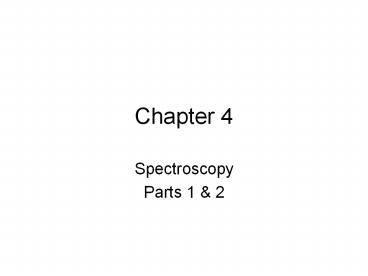Spectroscopy PowerPoint PPT Presentation
Title: Spectroscopy
1
Chapter 4
- Spectroscopy
- Parts 1 2
2
(No Transcript)
3
Describe the process that occurs inside atoms
that produces the spectra?
- Energy is absorbed by the atom.
- The electrons jump into higher orbits and the
atom becomes excited. - The electrons return to their original orbits and
the atom returns to the ground state. - The electrons release energy in the form of
visible light. - Each quantum leap produces a specific spectral
line of a certain energy (wavelength, frequency)
of visible light.
4
Quantum Leaps
- A quantum leap is a change of an electron from
one energy state to another within an atom. - Quantum leaps cause the absorption and emission
of electromagnetic radiation in which excited
atoms release small packets of electromagnetic
energy called photons.
5
Some Uses and Examples of Exciting Atoms
(Quantum Leaps)
6
Aurora Borealis
7
Northern lights (Auroras) are one of nature's
most beautiful manifestations of the ability of
electrons to jump between quantum states
8
What Causes the Aurora
- High speed energetic particles collide with atoms
in Earth's atmosphere to cause the aurora. These
high speed particles, which are usually
electrons, originate from space, specifically
from the solar wind, blowing outward from the
Sun. - When the electrons from space strike an atom or
molecule in Earth's atmosphere, they give one of
the electrons in the atom an energy boost. In
scientific jargon, the electron jumps to a higher
energy level and the atom is in an excited state.
9
What Causes the Aurora
- After a while, the electron in the excited atom
jumps back down to its original lower energy
level. It releases this energy as light causing
the auroral glow. This process is the same
mechanism that causes emission line spectra and
aurora are in fact emission line spectra of the
atoms in Earth's upper atmosphere. - The color of emission line spectra depends on the
type of atom that is excited, and each type of
atom produces its own unique pattern of colors.
Hence, the different colors in auroral displays
originate from different elements in Earth's
atmosphere.
10
What Causes the Aurora
- Oxygen molecules cause the green Aurora, and
oxygen atoms cause the red colors. Blue auroral
displays result from nitrogen molecules.
Molecular nitrogen and oxygen are the most common
constituents of Earth's atmosphere, so these are
the most common auroral colors. Mixtures of these
colors form the other colors of the auroras.
11
Northern Lights Video (357)
12
- Did you ever wonder how we know what the universe
is made of?
13
The entire article is posted near the door of the
classroom if you would like to read more.
14
Star Finder Video - Fingerprints of Light (1005)
Full Video (1350)
15
- Spectroscopy is the study of the energy which is
given off and absorbed when atoms go from the
ground state to the excited state and back again. - Spectroscopy is often used in chemistry for the
identification of substances, through the
spectrum absorbed or emitted.
16
Spectroscope
17
Fireworks
18
Neon Signs
19
Light Sources Mercury
- CFLs
- The average rated life of a CFL is between 8 and
15 times that of incandescents. CFLs typically
have a rated lifespan of between 6,000 and 15,000
hours, whereas incandescent lamps are usually
manufactured to have a lifespan of 750 hours or
1,000 hours.
Mercury Vapor Lamp
20
- Spectrum of a CFL bulb. The camera had a
diffraction grating in front of the lens. The
discrete images are produced by the different
colors in the light, a line spectrum. An
incandescent lamp would instead have a
continuous band of color.
21
American and 2 Japanese Physicists Share 2014
Nobel Prize for Work on LED Lights
22
LEDs
- LEDs, (Light emitting diodes), are found in all
kinds of devices. - They form numbers on digital clocks, transmit
information from remote controls, light up
watches. - Collected together, they form the illuminated
screens on cell phones and television screens. - Basically, LEDs are just tiny light bulbs that
fit easily into an electrical circuit. But unlike
ordinary incandescent bulbs, they don't have a
filament that will burn out, and they don't get
especially hot.
23
LEDs
- LEDs are illuminated solely by the movement of
electrons. - The lifespan of an LED is impressive lasting 10
times as long as a fluorescent bulb and 100 times
as long as an incandescent bulb. - LED bulbs do not have toxic mercury as do CFLs.
- Due to low power requirements, it can be powered
by cheap local solar power. Thus bringing the
advantage of electrical devices to places that
lack electrical power grids. - Currently upfront costs are higher than many
consumers which to pay but costs are continuing
to drop as technology improves.
24
- In the future, some of the most incredible uses
of LEDs will actually come from organic light
emitting diodes, or OLEDs which are flexible,
allowing scientists to create bendable lights and
displays. (Imagine rolling your TV up like a
poster and carrying it with you anywhere).
25
Lasers
- You'll find them in everything from CD players to
dental drills to high-speed metal cutting
machines to measuring systems. Tattoo removal,
hair replacement, eye surgery -- they all use
lasers.
26
What else can lasers be used for?
- Sharks
27
I want sharks with laser beams attached to their
heads.
28
Flame Tests
29
Flame Tests
- A flame test is a procedure used in chemistry to
detect the presence of certain metal ions based
on each element's characteristic emission
spectrum.
30
..\..\..\..\Videos\Flame Tests.wmv
Video Flame Tests (27seconds)
31
Video Molecular Fingerprints (15
min.)Worksheet is in notebook.
- ..\..\..\..\Videos\World of Chemistry\Molecular
Fingerprints.mpg
32
Homework
- Summarize the purpose and procedure for the
Flame Test Lab (Due tomorrow). - Chapter 4 Worksheet 3 (Due Friday).
- Study Guide Chapter 4 (Due Friday).

